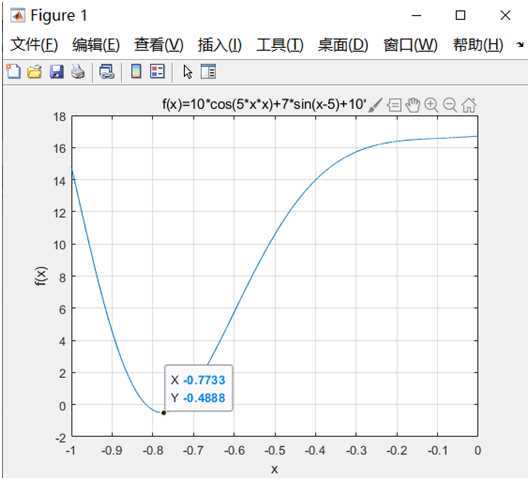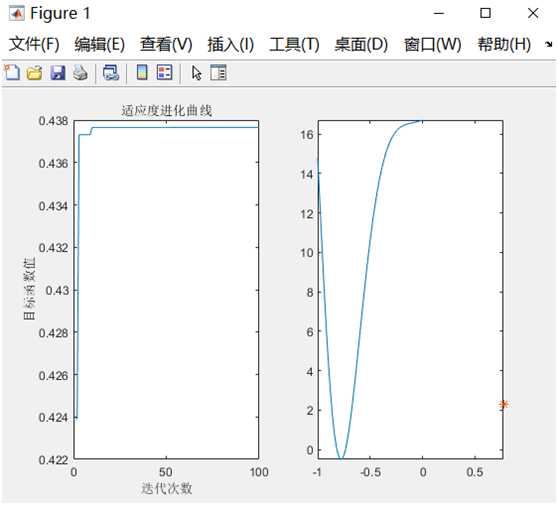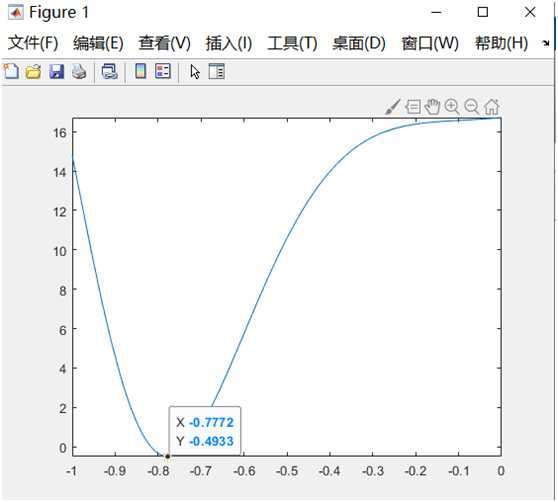基于Matlab用遗传算法求一元函数最值问题(附源码)
Posted horizon-asd
tags:
篇首语:本文由小常识网(cha138.com)小编为大家整理,主要介绍了基于Matlab用遗传算法求一元函数最值问题(附源码)相关的知识,希望对你有一定的参考价值。
问题:求y=10cos(5xx)+7sin(x-5)+10xx的最小值
要求:(1)用遗传算法编程求解问题
(2)编程语言用MATLAB 或C
(3)输出问题的最优解及最大值,并绘图显示
方法一
function.m
clear all;
close all;
clc;
x=-1:0.01:0;
y=10.*cos(5.*x.*x)+7.*sin(x-5.0)+10.*x.*x;
figure
plot(x,y)
grid on
xlabel(‘x‘)
ylabel(‘f(x)‘)
title(‘f(x)=10*cos(5*x*x)+7*sin(x-5)+10*x*x‘)
%%f(x)=10*cos(5*x*x)+7*sin(x-5)+10*x*x
1)运行结果
函数取(-1,0)定义域,能够显示出的X=-0.7733时,Y=-0.4888,图像如下

方法二
func.m
clear all;
close all;
clc;
x=-1:0.01:0;
y=10.*cos(5.*x.*x)+7.*sin(x-5.0)+10.*x.*x;
figure
plot(x,y)
grid on
xlabel(‘x‘)
ylabel(‘f(x)‘)
title(‘f(x)=10*cos(5*x*x)+7*sin(x-5)+10*x*x‘)
%%f(x)=10*cos(5*x*x)+7*sin(x-5)+10*x*x
main.m
clear all; %清除所有变量
close all; %清图
clc; %清屏
nvars = 1;
LB = -1;
UB = 0;
[t,fval] =ga(@test,1,[],[],[],[],LB,UB)
fplot(@(x)(10.*cos(5.*x.*x)+7.*sin(x-5)+10.*x.*x),[-1 0]);
hold on;
plot(t,fval,‘*‘);
function y = test(x)
y = 10*cos(5*x*x)+7*sin(x-5)+10*x*x
end
simple_fitness.m
%目标函数
x = -1:0.01:0;
%y=10*cos(5*x*x)+7*sin(x-5)+10*x*x;
y=10.*cos(5.*x.*x)+7.*sin(x-5)+10.*x.*x;
plot(x,y);
%%%%%%%%%%%%%%%初始化参数%%%%%%%%%%%%%%%
clear all; %清除所有变量
close all; %清图
clc; %清屏
NP=50; %种群规模(数量)
L = 20; %二进制位串长度
Pc = 0.8; %交叉率
Pm = 0.1; %变异率
G = 100; %最大遗传代数
Xs = 1; %上限
Xx = -0; %下限
f = randi([0,1],NP,L);%随机获得初始种群
xB =[];
%%%%%%%%%%%%%%%遗传算法循环%%%%%%%%%%%%%%%
for k = 1:G
%%%%%%%%%%%%%%%将二进制解码为定义域范围内十进制%%%%%%%%%%%%%%%
for i = 1:NP
U = f(i,:);
m = 0;
for j = 1:L
m = U(j)*2^(j-1)+m;
end
x(i) = Xx+m*(Xs-Xx)/(2^L-1);
Fit(i) = 1/func1(x(i));
end
maxFit = max(Fit);
minFit = min(Fit);
rr = find(Fit==maxFit);
fBest = f(rr(1,1),:);
xBest = x(rr(1,1));
xB(i)=xBest;
Fit = (Fit-minFit)/(maxFit-minFit);
%%%%%%%%%%%%%%%基于轮盘赌的复制操作%%%%%%%%%%%%%%%
sum_Fit = sum(Fit);
fitvalue = Fit./sum_Fit;
fitvalue = cumsum(fitvalue);
ms = sort(rand(NP,1));
fiti = 1;
newi = 1;
while newi <= NP
if (ms(newi)) < fitvalue(fiti)
nf(newi,:) = f(fiti,:);
newi = newi + 1;
else
fiti = fiti+1;
end
end
%%%%%%%%%%%%%%%基于概率的交叉操作%%%%%%%%%%%%%%%
for i=1:2:NP
p = rand;
if p < Pc
q = randi(1,1,L);
for j = 1:L
if q(j)==1;
temp = nf(i+1,j);
nf(i+1,j) = nf(i,j);
nf(i,j) = temp;
end
end
end
end
%%%%%%%%%%%%%%%基于概率的变异操作%%%%%%%%%%%%%%%
i= 1;
while i<= round(NP*Pm)
h = randi([1,NP]);
for j = 1:round(L*Pm)
g = randi([1,L]);
nf(h,g) =~ nf(h,g);
end
i=i+1;
end
f=nf;
f(1,:) = fBest;
trace(k) = maxFit;
end
xBest;
fBestt=func1(xBest);
subplot(1,2,1)
plot(trace)
xlabel(‘迭代次数‘)
ylabel(‘目标函数值‘)
title(‘适应度进化曲线‘)
subplot(1,2,2)
fplot(@(x)(10.*cos(5.*x.*x)+7.*sin(x-5)+10.*x.*x),[-1 0]);
hold on;
plot(xBest,func1(xBest),‘*‘);
%%%%%%%%%%%%%%%适应度函数%%%%%%%%%%%%%%%
function result = func1(x)
%fit = x+10*sin(5*x)+7*cos(4*x);
fit = 10.*cos(5.*x.*x)+7.*sin(x-5)+10.*x.*x;
result = fit;
end
1)运行结果

适应度曲线

函数图像以上是关于基于Matlab用遗传算法求一元函数最值问题(附源码)的主要内容,如果未能解决你的问题,请参考以下文章